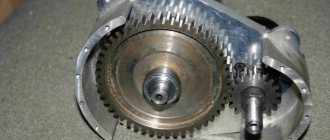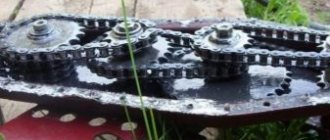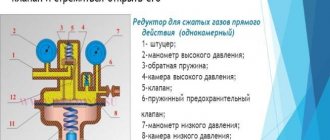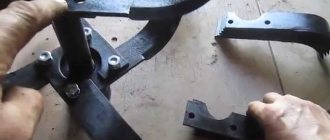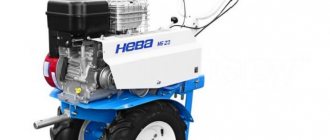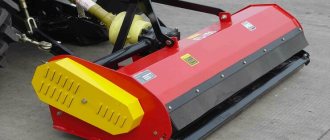Do-it-yourself angular gearbox
November 8, 2013. Read 24101 times.
Angular gearboxes are widely used in motor vehicles, especially modified cultivators, in the automotive industry, industry, for example, on valves, etc. The installed angular reduction gearbox on walk-behind tractors helps to achieve efficient operation under heavy loads.
This type of gearbox is usually used to connect an engine with a longitudinal crankshaft to a transmission designed for a chain. an angular gearbox with your own hands from existing samples, say, like on the Soviet Ural or Dnepr motorcycle. In this case, you will need to make a number of modifications that would suit your purposes for further use of the gearbox.
There are also available samples of angle-type gearboxes on sale, but they do not always fit the stated criteria of each buyer; the gearbox greatly reduces the speed, has a low gear ratio, or is not at all suitable in size for coupling with other mechanisms.
The second option is to make an angular gearbox yourself (angular gear motor). In this case, let's figure out what basic elements the gearbox consists of.
To assemble the bevel gear you will need:
- Phillips and straight screwdriver;
- ruler and caliper;
- needle files and files for metal;
— and other tools, depending on the size and type of bevel gear selected.
Homemade bevel gear with your own hands - step-by-step assembly process
First of all, you will need to calculate the rated power (Pn); Pn = Pe (hp) x FS - where you can find out the correct type of bevel gear angle. You will also need to calculate the RPM and torque.
Determination of operating conditions involves a number of factors such as the type of operating cycle (intermittent, continuous), radial and axial loads on the shaft ends, maximum and minimum temperatures, environmental conditions (such as dust and dirt levels) and type of lubricant. Once you have determined what technical parameters you need, we proceed to assembling the bevel gear.
Angular gear diagram
Diagram of an angular gearbox of a forced air cooling system
1 — housing (used from a generator from a Ural motorcycle);
2— generator rotor shaft without winding (used from the Ural motorcycle);
6—angular gearbox housing (fitting plumbing elbow 2″);
7— bevel drive gear (used from the gearbox of the Druzhba-4 chainsaw);
10—gear shaft bearing (2 pcs.);
11—housing for two gear shaft bearings (steel);
12—V-belt drive pulley of the forced air cooling system;
13—pulley fastening (spring washer with nut);
14—fastening the flange to the body (screw 3 pcs.)
Let's start assembling
As an example, let's take a detailed description of the manufacture of an angular gearbox for a homemade mini-tractor with an “articulated” frame. In this case, an angular gearbox is used for a forced air cooling system.
The cylinders of the power unit are equipped with an air cooling system. At the first stage, cooling was carried out using a general fan, but it was not effective. After this, the cooling system was modernized - each cylinder had its own impeller installed.
In this case, a 2″-inch fitting-plumbing elbow is used as the bevel gear housing. You can also make the housing for the bevel gear yourself by welding it from metal plates or select the appropriate size. Since the drive is connected through an angular gearbox (in our case, going to the fan), it can be made from a modified generator. The gears used in the bevel gear can be taken from the corresponding unit in the Druzhba 4 chainsaw. They just need to be modified. In one gear-shaft it is necessary to cut off the limit switch, after which we drill and grind holes in it to the corresponding diameter of the rotor-generator shaft we need. Next we put it on and weld it.
We install the second gear shaft, complete with race and bearings, into the bevel gear housing on the opposite side. On the output shaft of our bevel gearbox, a pulley will be mounted that transmits rotation directly through a V-belt drive (as shown in the diagram above), onto each pulley of two fans that are located above each engine cylinder. We weld the fan bearing races to the hood ramp. The pulleys were taken from a washing machine, the fans in this case were used from the heating radiator of a UAZ-469 car.
Source
Equipment
Converters are either collapsible or non-dismountable. Basically, the latter type can often be found in the configuration of budget walk-behind tractors. They feature inexpensive spare parts that cannot be replaced. In the event of a breakdown, there is only one way out - replace the entire gearbox. The service life of such models declared by the manufacturers is 1-2 seasons, provided they are used correctly.
More expensive equipment can boast of a dismountable gearbox that can be repaired: failed parts can be replaced with new ones. Therefore, the service life is several times longer compared to inexpensive devices.
The converter package consists of:
- Cases - collapsible or not.
- The rotor shaft is responsible for torque.
- Gears of different sizes.
- Chain or belt - depends on the type of gearbox. In the case of a chain transmission, movement occurs due to sprockets - star-type disks. If the transmission is belt driven, then the equipment has pulleys on which the belt is put.
- Bearings - reduce friction between rotating elements and ensure their free rotation.
Through these components, movements are transmitted from the motor to the attached parts. Belt converters are weaker and unreliable. If the torque is high, then the belts begin to fly off the pulleys. But such a structure has a positive effect on the engine shaft. This situation can be avoided by replacing them with gear ones. But then you will have to change the pulleys too.
All parts are located inside the case. In addition to the installed set of components, you can also add elements for lubrication of bearings inside the device. These include an oil pump or a cooling device.
Materials used:
- Small bevel gear Z-16 (1.65/1.85 WIRAX 5036/010660) from a rotary mower Poland. — 2 pieces — 2300 rub.
- Drive shaft of small pulley 5036010260 (2 keys) - 2 pcs - 1000 rub.
- Bearing 180305 - 4 pcs - 600 rub.
- The key is 12*8*50 (mower mouth), but I spread it along the poles, lengthwise - 2 pieces - 100 rubles.
- In total, we get 4,000 rubles worth of materials.
The bearings are pressed onto the shaft, then inserted into the cage, the cage is tightened with clamps as much as possible and then welded so that the metal is pulled in during welding and the bearings are clamped.
The result is this, a homemade bevel gear made with your own hands. Will be installed on a segment mower.
Source
Safety clutch
How to make a scissor lift with your own hands video
It is installed to prevent gearbox destruction during emergency jamming. Can be made in the form of friction clutches or a pin.
You can complete the work of self-assembly and selection of the necessary parts by reading the instructions and recommendations on the Internet.
Most often, it is used to reduce the rotation speed. For example: a boat cannot reach the speed its engine produces. Therefore, an angular gearbox is installed that reduces the propeller speed.
A correctly selected and high-quality bevel gearbox protects your equipment from overloads during operation. Maintenance and timely repair work will allow the equipment to perform its task without accidents and major repairs.
Types of gearboxes
There are worm and chain devices.
The differences between them are small, but quite important. The difference lies in the characteristics inherent in the two different types: efficiency; angular velocity; number of gears; number of shafts and ratio between gears. Relatively cheap walk-behind tractors are often equipped with non-separable gearboxes for simplified assembly . In this case, the service life is significantly reduced and additional possibilities are eliminated:
This indicates the low quality of the material used to manufacture the gearbox, and that most of the parts will not be sleeved. The diagram will give an idea of the principle of its operation and service life.
Expensive walk-behind tractors are equipped with gearboxes that are more complex in design and allow further assembly and disassembly. Maintenance can be carried out by correcting all the shortcomings in the operation of the device.
Repairs are carried out in order to extend the service life. It is recommended to replace faulty parts with more expensive ones. Timely lubrication will also extend the service life.
In most cases , the gearbox converts speeds , that is, the angular speed is quickly and efficiently transformed into a low one. There will be a high angular velocity on the input shaft, and a low one on the output shaft.
To prevent unexpected breakdowns, regular high-quality maintenance . When changing speed in steps, the gearbox is called a gearbox. When a step system is not used, the device is called a variator.
Gear housing
This is the main part and the alignment of the shafts and axles installed in it, and the gaps between the gears depend on its correct manufacturing. In industrial production, the body is cast from metal. It is impossible to make such a case on your own, without equipment, so if you make it yourself, there are 2 options:
- select a ready-made case from other equipment;
- make a homemade steel body by welding and bending metal.
In the second method, the deformation of the structure during heating should be taken into account. Leave small tolerances in the places where the bearing is secured to the shaft or axle, as well as in the place where the oil seal is installed. You should not weld the bearing to the housing - this will affect its operation and problems during replacement. To make it easier, you can select a pipe of suitable diameter, weld it to the body and press in the sliding supports.
To make repairs and maintenance easier, the housing should be closed with a protective cover. At the top, a hole is made with a plug for filling in new transmission oil; at the bottom we place a plug for the waste drain.
Types of gear units
The transmission of rotational motion from the motor shaft to the actuator shaft can be carried out by direct connection of the axes, if the speed and power of rotation of the engine are acceptable for operation, and the axes of the drive and driven shafts coincide. Such cases are extremely rare, and with several attachments for different purposes, direct transmission absolutely cannot be used. To match the speed and power of the drive and driven shafts, 4 types of mechanisms and their combinations are used. Main types of gears:
The worm gear is structurally limited by the speed-reducing function; the rest can be used in both downshifts and overdrives. In addition, such a gearbox always has a driven axis perpendicular to the drive shaft. This scheme is called an angular gearbox. In addition to the worm gear, you can change the direction of the axis using a spatial planetary mechanism. Belt and chain drives keep the driven axis parallel to the engine axis. In simple devices, reverse is possible only when the rotation of the engine changes.
Motoblocks use engines with a high number of revolutions per minute, which can be verified in the product data sheet. This means that you need to make a gearbox with your own hands to reduce the speed, and it is better to choose what type of homemade gearbox for a walk-behind tractor, knowing the characteristics of each type.
Belting
The pulley or belt that transmits rotation from shaft to shaft is familiar to every motorist who has looked under the hood of the engine compartment. The rotation speed reduction coefficient is determined by dividing the radius of the small driven wheel by the radius of the large driving wheel.
The advantages of belt gearboxes are their ease of manufacture and repair, and a wide variety of parts. And the disadvantages of the belt:
- belt stretching, decreased adhesion to the pulley due to temperature and wear;
- slippage during sudden increases in torque;
- short service life.
The shortcomings are compensated by using a spring-loaded roller that presses on the surface of the belt between the wheels, and by using a toothed belt on pulleys with transverse chamfers. Belt gearboxes require the drive and driven pulleys to be in the same plane; bending or twisting the belt will quickly lead to it breaking.
Chain type
The operating principle of a chain drive is similar to a belt drive, but sprockets are installed instead of pulleys, and the belt is replaced by a chain.
Such a homemade gearbox will not allow slipping, and under similar conditions it will work much longer. Just like a belt gearbox, a chain gearbox must have drive and driven sprockets in the same plane, and its gear ratio is calculated by the ratio of their teeth. The weight of this design is greater than that of a belt design, but it is safer to install it on powerful walk-behind tractors.
Unlike a belt drive, a chain drive requires caution or additional protective measures. If a rotating implement collides with a thick root in the soil, its drag force will be transferred to the motor, possibly damaging it. Until the engine fails or switches off, it will try to rotate with maximum power along with the frame around the driven axis of the gearbox. The greater the engine power, the stronger the tipping torque will be.
The gear ratio of a chain gearbox can be higher than that of a belt gearbox of the same size, since the drive sprocket, even having a small size, will not allow the chain to slip.
In terms of cost, ease of assembly, and prevalence of parts, a chain drive is not inferior to a belt drive.
Using gears
A walk-behind tractor with a gear reducer is more reliable and durable than one with a chain or belt drive. Gear structures are installed on factory products, and not only on walk-behind tractors. The units are small in size as a result of combining two gears with different diameters on one axis. For a walk-behind tractor, for example, a gearbox from an Ant scooter is perfect. But you can make your own using gears from motor vehicle gearboxes.
Main types, their purpose
A gearbox is equipment that allows the use of an engine in the design of various units. Rotation from the motor is transmitted to the car wheel and boat propeller. In this case, the force increases, with a decrease in the rotation of the motor shaft.
In the household, walk-behind tractors and cultivators are most often used. According to their design features, they can be installed:
- Gear mechanism. Bevel or cylindrical gears are pressed onto the drive shafts. This design allows them to be used in direct transmission of rotation from the engine. Can be used as an angular gearbox for a walk-behind tractor, while the design uses a bevel gear.
- The device is gear-worm. Most often installed with a vertical engine crankshaft. A gear with a certain number of teeth and a worm screw with a certain thread pitch is a schematic description of the type of device. The main feature is the transmission of rotation of the engine shaft at a right angle.
- Chain device. The shafts are equipped with toothed sprockets. They are wearing a special chain, with the help of which torque is transmitted from the motor. For good performance, the chain is tensioned using a tensioner roller.
- Belt device. Rotation is transmitted using belts. Pulleys with grooves for belts are pressed onto the shafts, and the belt is tensioned using a tension screw.
Most often, in equipping the angular gearbox of a boat motor, walk-behind tractors and other mechanisms, a chain, gear or gear-worm gear is used. Previously, the main one was the belt system; due to breaks, the belt slipping off the pulleys, its operation was considered unreliable.
To make a homemade bevel gear, you need to know its operating principle and how to make them at home.
Manufacturing or selection of ready-made structures
With access to a wide range of components: a junkyard of old equipment or abandoned property of a repair shop, it is possible to manufacture a gearbox with an accurate selection of the gear ratio.
However, such a complex structural element requires serious metal processing equipment. You can select a housing of the appropriate size, drill holes for the shafts on the bearings, and assemble the structure no worse than the factory one.
However, experience shows that the selection of ready-made structures with minor modifications is much more effective. As an example, consider a homemade walk-behind tractor based on an engine from an IZH motorcycle.
A proprietary gearbox is used, with the ability to change speeds. The standard gear ratio is not enough, although a small sprocket on the output shaft of the gearbox, combined with a large sprocket from the drive wheel, already provides a good reduction in speed.
The shaft, installed in the bearing podium, is equipped with another small sprocket, which, using a second chain, transmits torque to the wheels. In turn, a large diameter star is installed on the drive axle.
The result is a design with two-stage rev reduction and solid torque. By using the motorcycle gearbox, you can select the required speed without using the throttle. The engine almost always runs at idle speed, which prolongs its service life.
No less popular is the use of a ready-made gearbox from the Ant scooter.
It is not necessary to use the entire wheeled platform; it is enough to install your rollers on the bridge. By using the gearbox from the selected power plant, you will get the optimal ratio of power and speed.
Video: modification of the gearbox of the Neva walk-behind tractor.
Gearbox manufacturing process
First, the parameters of the power plant are calculated. The crankshaft speed can be found in the technical specifications.
This is the first quantity required to perform the calculation. The value is not constant, with the addition of “gas” the number of revolutions increases. Basic value: idle speed +10% .
Next, the suspension axle revolutions are calculated . Knowing the size of the wheels, it will be possible to calculate the amount of run-out per revolution. The number of axis revolutions is calculated to ensure a comfortable speed - 3-5 km/h, which is the second value for design.
For example, idle speed +10% is 600 rpm. The required wheel axle speed for 3 km/h is 200 rpm. So, the gear ratio should be 3:1 . The rotation speed of the axis is reduced by three times in relation to the speed of the motor shaft, and the torque increases accordingly by three times. Gearbox types:
- Gear - use the ratio of the number of teeth of the driven and driving gears. The device operates on the principle of steam in the gearbox. It doesn’t matter what shape the gears have - the teeth can be straight or oblique. A bevel gear is used when a walk-behind tractor requires an angular gearbox. It all depends on the location of the motor. If alignment is ensured between the motor shaft and the wheels, an angle is not required.
- A worm drive is needed to create a large gear ratio when there is a large difference between the revolutions of the drive axle and the engine. This design is more difficult to manufacture and maintain. The solution is optimal if the motor shaft is perpendicular to the wheel axis.
- Chain gearboxes work like a bicycle, but in reverse. The leading one is a smaller star. The reliability of the design is determined by the quality of the gear metal and the strength of the chain. A simple set from a bicycle may not withstand the load, so more durable ones are used - motorcycle ones.
- Belt devices are the simplest to manufacture. They are also the most unreliable and weak. Large torque is not transmitted, as the belts will slip. But the shock load on the engine is reduced - the design is more gentle on the drive shaft, jerks are smoothed out. Slippage is eliminated by installing a timing belt. In this case, you need to find a pair of toothed pulleys, for example, from an automobile timing system.
- Combined system. A device with a chain and gear drive can be manufactured in one housing, although the calculations in this case are more complex. But it is possible to transmit enormous torque with low engine power.
When choosing any design, do not forget about the following rules:
- do not allow distortions between the driven and driving parts;
- Bushings cannot be used, only bearings.
Any device other than a belt one must be constantly lubricated, therefore it must be in a box. The sealed housing will protect against dirt and dust, the ingress of which is inevitable during field work. Oil seals are installed on the shafts.
As an example, we can take factory products for Soviet agricultural machinery. The chain drive is not so sensitive to lubrication, but the chain must be cleaned and lubricated regularly .
Finalization of the finished design
You can choose a housing of a suitable size from a junkyard of old equipment, drill holes for the shafts on the bearings and assemble the device no worse than the factory one! Practice shows that selecting ready-made structures with minor modifications is much more effective.
An example for us will be a homemade unit based on the IZH motorcycle engine . A “native” gearbox with the ability to change speeds is used. The standard gear ratio is missing, but a small sprocket on the output shaft of the gearbox with a large sprocket from the drive wheel already provides a good reduction in the speed.
Another small sprocket is put on the shaft, which is installed in the bearing podium, which transmits torque to the wheels using a second chain. The drive axle, in turn, is equipped with a large diameter star. The result was a design with a 2-stage speed reduction and high torque.
Using a motorcycle gearbox , you can select the required speed without using the throttle. The engine almost always runs at idle speed, which extends its service life.
No less popular is the ready-made gearbox from the Ant scooter . There is no need to use the entire wheeled platform; installing your rollers on the bridge will suffice. By using the gearbox from the selected engine, you will get the optimal ratio of speed and power.
Types of mechanisms
According to the method of operation and action, all transforming mechanisms for walk-behind tractors are divided into several types:
- angular;
- downward;
- reverse with reverse speed (reverse gearbox);
To redirect rotational energy from a vertical drive to a horizontal plane, an angular gearbox using bevel gears (bevel gearbox) is used.
Reducing the number of revolutions and increasing the power of the drive mechanism is provided by reduction gearboxes, or creepers for the walk-behind tractor. They are considered the most reliable for operating a diesel or gasoline air-cooled walk-behind tractor. This allows them to be used for particularly difficult work - for example, plowing heavy soil or harvesting potatoes using a potato digger.
Varieties
The gearboxes with which walk-behind tractors are equipped seem identical only at first glance. In fact, these devices can be divided into three groups. The differences lie in the design features of the gearboxes. Let's get to know the representatives of this family in more detail.
Angular
Angle-type gearboxes are elementary structures that serve to connect the transmission to the power plant of the unit.
The structure of this node looks like this:
- Mechanism body.
- Belt drive pulley with fastening.
- Rotor shaft.
- Flange complete with mounting and bearing.
- Washer and fixing key.
Gear
This is a more complex mechanism, which is impossible to recreate at home without special skills and knowledge.
Gear reducers are called reduction gearboxes. Thanks to its design features, the mechanism reduces the engine speed, simultaneously increasing the power output of the walk-behind tractor.
Such gearboxes have a long service life, so they are suitable for performing various jobs, and do not suffer mechanical damage even under peak loads.
Reversible
This mechanism is based on a clutch that moves freely between bevel gears.
Such gearboxes enable the walk-behind tractor to move in reverse, which has a positive effect on the maneuverability of the equipment.
However, this comes at the cost of reduced performance and maximum speed. Therefore, each farmer decides independently whether to install a reversible gearbox or not.
Gearboxes installed on walk-behind tractors from different manufacturers have virtually no design differences. Therefore, disassembling the unit and replacing failed parts will not cause difficulties.
What is a gearbox?
This mechanism is a transmission link that is located between the rotational devices of an electric motor or internal combustion engine to the final operating unit.
The main characterizing indicators of the gearbox are:
- transmitted power;
- efficiency;
- number of driving and driven rotary shafts.
Gear or worm gears are fixedly attached to the rotational devices of this mechanism , which transmit and regulate movement from one to another. The housing has holes with bearings on which the shafts are located.
Angular gearbox: device, purpose and principle of operation
Gearboxes are installed on various mechanisms. These can be large ships and a small boat; mechanisms for agricultural machinery and cars are equipped. Inexpensive units are equipped with one-piece, maintenance-free gearboxes. Therefore, you can extend the life of your irreplaceable assistant with your own hands at low cost.
Powerful devices and small gearboxes have the same structure and operating principle.
Peculiarities
Chain gearboxes can be different, but mostly they are dismountable, that is, they have a bolted connection. This makes it possible to carry out easy visual diagnostics, identify any deviations in gears and chains in a timely manner, and the lubricant will be conveniently applied to the mechanism.
The main advantages of chain gearboxes include:
- Availability of reverse function;
- Simple operation;
- High level of conveyor reliability.
The most common failures of chain gearboxes are associated with chain rupture or stretching. These faults are very easy to fix even by people who do not have special technical skills. This is a big plus, since repairing a chain gearbox does not require contacting a specialist.
The gearbox has a fairly simple structure. Among its components, we can note a chain and two sprockets, upper and lower. The lower sprocket is located on the working shaft, due to which the mechanism operates, in which lubricant is used to reduce its wear. A manual chain reducer works on the same principle. The existing gear ratio on the stars allows you to increase the force on the cutters. This version has a thin body, as this ensures maximum penetration of the cutters. The housing is equipped with holes with bearings, and the shafts are located on them. Below we will describe the process of how to assemble a chain gear yourself and carry out calculations.
Gearbox sliding bearings
The bearing facilitates the rotation of the shafts, removing the friction force through its work. You should remember about the correct selection of this part and proper installation. The sliding support must fit into the seat firmly and forcefully to prevent rotation. It is better to use closed parts. Before installation, it is better to remove the cover and fill the balls and internal support with new grease. When using helical gears or a worm gear, the best option would be to install roller or angular contact ball bearings.
Walk-behind tractors with a gear reducer and a reduction gearbox for a walk-behind tractor
A reduction gearbox for a walk-behind tractor, in common parlance a speed reducer, is installed on modern air-cooled diesel and gasoline walk-behind tractors. Thanks to this, the user can use the walk-behind tractor on particularly heavy soils for plowing and digging up potatoes. The reduction gear helps with wheel slipping when there is not enough own power.
Motoblocks with gear reducer
To understand what a gear reducer is, let’s look at the structure of the transmission. It transmits torque from the engine to the wheels, and changes the speed and direction of movement of the walk-behind tractor. The transmission consists of a gearbox, differential, gearbox and clutch. Transmission units can be gear, chain, belt, or a combination of one or the other. The gear transmission consists of bevel and spur gears (gear reducer). It is used on some models of cars and heavy walk-behind tractors. The figure shows the gear transmission of the Ugra NMB-1 walk-behind tractor, which uses a gear reducer.
Source
Kinds
Depending on the type of transmission used in the gearbox, converters are divided into several types. Different devices are used in mechanisms of different fields of activity.
Chain
The name is due to the design of the gearbox, which is based on a chain as a transmitting element. There may be more than one in one device. The movement is provided by sprockets, the small one is the leading one, the big one is the driven one. The principle is similar to the system on a bicycle. Productivity and reliability depend significantly on the quality of materials used to manufacture the main driving parts.
Among the negative aspects, the need for regular maintenance should be highlighted: chain tightening, lubrication. Unlike a belt drive, a chain drive does not allow slipping and lasts longer.
With reverse
The reversing mechanism provides the equipment with the ability to reverse. In this case, the reverse rotation clutch is installed between the bevel gears, which are located on the main shaft.
Belt
The simplest gearbox available on the market is of the belt type. As a rule, budget gearbox models use just such a device. The belt serves as a transmission element that is attached to the pulleys. Under heavy loads, the belt slips or breaks.
Belt converters reduce the aggressive effect on the power plant, reducing jerking. In addition, their design is simple and repairs are easy.
Among the minuses, unfortunately, there are more factors.
- At high temperatures the belt stretches. This is what reduces grip.
- Rapid wear and tear.
- Belt drive rupture due to kinks or twists.
- As the speed increases, the belt begins to slip.
- The pulleys must be in the same plane.
Gear
Gear reducers are most often used in engines of heavy equipment. The transmission consists of a gearbox, differentials and regulator, gears and belts. The design of the device is simple.
A gear transmission contains bevel or spur gears. Due to the fact that several of them can be placed on one shaft at once, the dimensions of the converter are reduced.
Among the advantages, one can also highlight the quietness of the engine on this type of gearbox.
Worm
The worm gear inverter features long service life and high reliability. The design is considered not very complex and requires qualified maintenance. The worm gear is already angular. In addition, it has a reverse, which allows the equipment to move not only forward, but also backward.
The gearbox got its name from the presence of a special worm gear in its composition, which moves along a screw having a trapezoidal four- or two-start thread. By varying the number of teeth, you can change the rotational speed. All components are made of anti-friction steel, which is characterized by increased strength.
The converter consists of only two main components. In addition, it is quiet and smooth.
Angular
One of the most efficient and reliable gearboxes. Therefore, it is used to equip production machines and equipment operating under heavy loads. This type of converter is also actively used in the automotive industry.
The angular gearbox ensures the connection of the engine with the transmission, which is designed for chain drive
Please note that the magnitude of the load will depend on the quality of lubricants and temperature conditions
Downward
The goal of a reduction gearbox is to reduce the number of revolutions while increasing power. This is achieved by using a gear system. As a rule, modern converters of this type are equipped with an air cooling system.
